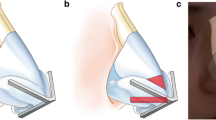Abstract
Background
This report aims to demonstrate the advantages of the sliding technique for reducing an overprojected tip.
Methods
In this study 271 patients (201 females, 70 males) were treated using this technique. It was used for isolated tip hypertrophy (N = 93) and combined deformities (N = 147).
Results
A medial sliding was performed in 109 patients, a lateral in 125 patients, and a combined lateral and medial sliding was used in 9 patients. Twenty patients needed additional skin resection at the columella. Follow-up of our first 80 patients showed an average reduction of around 11%. Only one patient of 80 in this study had to be revised.
Conclusion
The sliding technique is safe and reliable as well as a logical and effective technique to deproject the nasal tip.










Similar content being viewed by others
References
Sheen JH (1978) Aesthetic rhinoplasty. C.V. Mosby, St. Louis, pp 232–255
Joseph J (1931) Nasenplastik und sonstige Gesichtsplastik nebst Mammaplastik. Verlag von Curt Kabitzsch, Leipzig, pp 82–167
Kreutzer Ch (2005) Die Reduktion der überprojizierten Nasenspitze mit der Sliding-Technik. Retrospektive Analyse zur Quantifizierung des Operationsergebnisses. Dissertation, Ruprecht-Karl-University of Heidelberg
Goldman IB (1957) The importance of the medial crura in nasal tip reconstruction. Arch Otolaryngol 65:143–147
Tardy ME, Walter MA, Patt BS (1993) The overprojecting nose: anatomic component analysis and repair. Facial Plast Surg 9(4):306–316
Rees TD (1980) Rhinoplasty. In: Aesthetic plastic surgery, vol 1. W. B. Saunders, Philadelphia, pp 102–242
Simons RL (1987) Vertical dome division in rhinoplasty. Otolaryngol Clin North Am 20(4):785–796
Papanastasiou S, Logan A (2000) Management of the overprojected nasal tip: a review. Aesthetic Plast Surg 24:353–356
Fredericks S (1974) Tripod resection for “Pinocchio” nose deformity. Plast Reconstr Surg 53:531–533
Guyuron B (1991) Dynamics of rhinoplasty. Plast Reconstr Surg 88(6):970–978
Daniel R (1999) Rhinoplasty—an atlas of surgical techniques. Springer Verlag, New York, pp 352–358
Anderson JR (1969) The dynamics of rhinoplasty. In: Proceedings of the 9th international congress of otolaryngology, International Congress Series 206. Excerpta medica, Amsterdam
Lipsett EM (1959) A new approach to surgery of the lower cartilaginous vault. Arch Otolaryngol 70:42–47
Adamson PA (1988) Refinement of the nasal tip. Facial Plast Surg 5(2):115–134
Kastenbauer E (1989) Was hat sich in der ästhetischen und funktionellen korrektiven Nasenchirurgie geändert? Laryngorhinootologie 68:4–11
Gunter JP, Rohrich RJ (1987) External approach for secondary rhinoplasty. Plast Reconstr Surg 80(2):161–173
Behrbohm H (2003) Die funktionell-ästhetische Nasenchirurgie. Notabene medici Sonderdruck 33. Jahrgang 4(5):154–158
Hamra ST (1993) Crushed cartilage grafts over alar dome reduction in open rhinoplasty. Plast Reconstr Surg 92:352–356
Adamson PA, McGraw-Wall BL, Morrow TA, Constantinides MS (1994) Vertical dome division in open rhinoplasty. An update on indications, techniques and results. Arch Otolaryngol Head Neck Surg 120(4):373–380
Foda HM, Kridel RW (1999) Lateral crural steal and lateral crural overlay. An objective evaluation. Arch Otolaryngol Head Neck Surg 125(12):1365–1370
Constantinides M, Liu ES, Miller PJ, Adamson PA (2001) Vertical lobule division in rhinoplasty: maintaining an intact strip. Arch Facial Plast Surg 3(4):258–263
Foda HM (2001) Alar setback technique: a controlled method of nasal tip deprojection. Arch Otolaryngol Head Neck Surg 127(11):1341–1346
Aiach G (2002) Correction of alar cartilage deformities. In: Open rhinoplasty and cartilage grafting. Endo-Press, Tuttlingen, p 8
Gubisch W, Kotzur A (2003) Nasenspitzenkorrekturen über offenen Zugang. Sekundäre Rhinoplastik 2. Mag Aesth Chir 1:14–21
Tebbets JB (1994) Sharing and positioning the nasal tip without structural disruption: a new systematic approach. Plast Reconstr Surg 94:61–65
Neu BR (2001) Reduction of nasal tip projection with medial rotation of alar cartilages. Plast Reconstr Surg 108(3):763–767
Acknowledgments
The authors are grateful to their current fellow, Dr. Pedram Imani from Perth, Australia, for reviewing the manuscript and Dr. Florian Sandweg for the statistics.
Author information
Authors and Affiliations
Corresponding author
Rights and permissions
About this article
Cite this article
Gubisch, W., Eichhorn-Sens, J. The Sliding Technique: A Method to Treat the Overprojected Nasal Tip. Aesth Plast Surg 32, 772–778 (2008). https://doi.org/10.1007/s00266-008-9211-1
Received:
Accepted:
Published:
Issue Date:
DOI: https://doi.org/10.1007/s00266-008-9211-1




